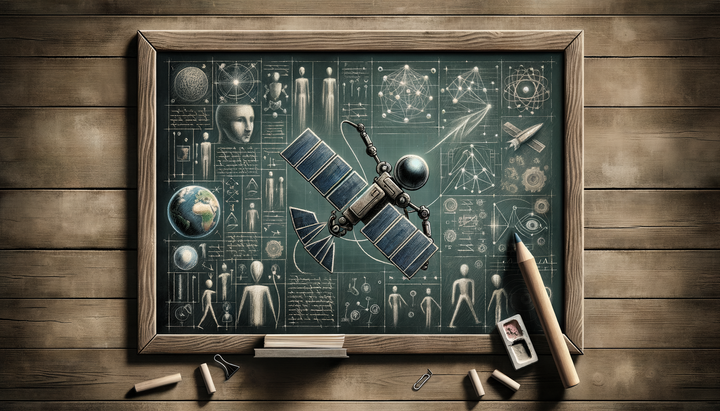Zeta's Customizable AI Agents and Advancements in AI

This article explores the rapidly evolving landscape of artificial intelligence across diverse sectors – from revolutionizing medical diagnostics and enhancing marketing strategies, to redefining data security, transforming user interaction on mobile devices, and even challenging our perceptions of visually generated content. By examining groundbreaking advancements like an AI that detects gluten-induced damage overlooked by doctors, innovative platforms that empower marketers to build custom AI agents, shifts in investment strategies and testing paradigms, strategic hires to drive AI-based data security, and the uncanny valley observed in AI-generated food images, we delve deep into how these technologies are reshaping industries. We also touch on how leading companies are positioning themselves for the future, offering insights and examples drawn from recent developments and research.
AI in Healthcare: Detecting the Undetected
In a stunning development for healthcare technology, an innovative AI system has been making headlines by identifying gluten-induced damage that often eludes conventional medical examinations. A recent report by SciTechDaily titled “New AI Sees Gluten Damage Doctors Often Miss – And Diagnoses Celiac in Seconds” details how this system accelerates the diagnosis of celiac disease, a condition notoriously difficult to spot in its early stages. Traditionally, doctors have relied on various tests and invasive procedures to confirm such conditions, but this breakthrough AI can analyze subtle tissue changes that indicate gluten damage, offering rapid diagnostics and enabling early intervention.
This technology not only promises to revolutionize patient care by reducing the time to diagnosis but also raises interesting questions about the future role of AI in clinical settings. By integrating machine learning with advanced image recognition, this system exemplifies how AI can support and enhance the work of healthcare professionals. The implications are significant: earlier detection means more effective management of celiac disease and possibly other autoimmune conditions triggered by environmental factors.
As healthcare systems worldwide grapple with increasing patient loads and the need for accurate, swift diagnostics, such AI innovations could prove to be indispensable tools. They open up a realm of possibilities where human expertise is complemented by digital precision. Think of an elderly patient in a remote area who can receive a life-changing diagnosis in seconds, rather than days or weeks – this is the true promise of merging technology with human care.
"Artificial intelligence is the science of making machines do things that would require intelligence if done by men." – Marvin Minsky, Semantic Information Processing
Adoption barriers remain, such as regulatory challenges, but the potential for AI to assist in diagnostic processes is undeniable. Decisions on integrating these systems will have to be informed by rigorous testing and transparent validation studies – something that every forward-thinking institution in the medical field will now have to consider as they look to the future.
Empowering Marketers: Building and Customizing AI Agents
The marketing world is experiencing its own AI revolution. As outlined in SiliconANGLE News’s article “Zeta to let marketers build and customize AI agents,” companies are now provided with the tools to create tailored AI solutions that can adapt to dynamic customer needs. This platform empowers marketers to fine-tune AI agents specifically designed to enhance the customer experience, analyze market trends, and create personalized campaigns that resonate deeply with target audiences.
By allowing a flexible customization process, Zeta’s platform is a major step toward bridging the gap between off-the-shelf software and bespoke marketing solutions. Marketers can build AI agents with specific functionalities – whether it's analyzing consumer behavior patterns, optimizing ad buys in real time, or creating content dynamically. The role of such platforms is to seamlessly integrate with existing digital tools, providing an ecosystem where human creativity and machine efficiency converge.
The evolution of custom-built AI agents reflects a broader shift in the industry: businesses are increasingly casting aside one-size-fits-all solutions for systems that adapt to their unique challenges. With marketers now armed with sophisticated data analytics capabilities, the possibility to optimize campaigns, predict consumer trends, and even understand sentiment analysis in real time is finally within reach.
"Science Fiction, is the last great escape." – A.R. Merrydew, Inara
This move raises pertinent discussions about the role of AI testing and development investment. As businesses invest more in AI, the need for thorough validation and testing becomes paramount. The recently highlighted concerns in the Applause 2025 AI Survey, where insufficient prioritization of testing was flagged, serve as a cautionary note even as innovation continues at breakneck speed. For companies eager to harness AI’s full potential, aligning innovation with rigorous testing protocols is essential.
For further insights on innovative marketing technologies and their impact on the digital landscape, check out more stories on our Marketing and Innovation updates section at AI.Biz.
The Dynamics of AI Investment and Testing
While the promise of AI is expansive, industry surveys such as the Applause 2025 AI Survey highlight a critical gap: the failure to prioritize robust testing and to embed generative AI techniques into development cycles. According to data aggregated from industry leaders, the rush to integrate AI into existing systems often leads companies to bypass crucial developmental checks in favor of rapid deployment. With investments in AI growing, this dichotomy highlights a potential misalignment between capital influx and operational rigor.
It is imperative that organizations not only invest in state-of-the-art AI capabilities but also develop standardized protocols to ensure that these systems are reliable and ethical. This is particularly important when these solutions are integrated into sensitive sectors, ranging from healthcare to security and beyond.
Historically, technological booms have sometimes been marred by short-sighted implementations, leading to challenges down the road. The current landscape calls for a balance – embracing the rapid development of AI while ensuring that quality and safety are never compromised. In this regard, the survey findings serve as an industry-wide call to action: adopt rigorous embedded testing mechanisms, standardize best practices, and continuously reassess the systems as they evolve.
In this context, it is interesting to draw parallels with other sectors where thorough testing is critical. Software companies, for example, invest heavily in beta testing phases and user feedback loops to ensure product viability. The world of AI is no different – except that its impact can be far more profound, affecting both human lives and secure business operations. Organizations that recognize and act upon this will likely lead the way into an era of responsible AI innovation.
Transforming Data Security Through Strategic Leadership
A pivotal moment in the realm of AI-enhanced data security has emerged with NVISIONx’s strategic appointment of Ben Rowe as its Chief Technology Officer, as reported by Yahoo Finance in the article “NVISIONx Appoints Ben Rowe as Chief Technology Officer to Accelerate AI-Driven Data Security Innovations.” Rowe’s impressive background in engineering and enterprise-scale system development positions him uniquely to spearhead advancements in agential AI to tackle modern cybersecurity challenges.
As cyber threats become more sophisticated, the necessity for integrated security tools that can analyze large data sets in real time is more pressing than ever. NVISIONx’s innovative Nx + RexAI Platform exemplifies how AI-driven visual analytics can empower multidisciplinary teams—from business leaders to cybersecurity experts—to collaborate effectively. With Rowe’s leadership, the company is not only focused on technological innovation but is also addressing compliance and legal challenges that come with managing sensitive data.
This initiative underscores a broader trend in the enterprise market: the merging of operational excellence with cutting-edge AI capabilities to build resilient data security architectures. Rowe’s integration of Generative AI (GenAI) technologies into the security framework is poised to help organizations gain clear visibility into their data landscapes, making it easier to identify vulnerabilities and mitigate risks. His multi-disciplinary expertise acts as a cornerstone for the emerging era of AI in data governance.
For businesses navigating the labyrinth of cybersecurity challenges, NVISIONx is paving a new path with advanced AI that monitors, predicts, and counters potential threats. This move not only reassures customers but also serves as a blueprint for other companies in the sector looking to merge innovation with practical, user-friendly security solutions.
The Unsettling Aesthetics of AI-Generated Food Imagery
Not every AI innovation creates a warm embrace among users—some spark unexpected reactions that challenge our cognitive biases, as shown in the intriguing study reported by PetaPixel entitled “AI-Generated Food Images Can Make People Feel Uncomfortable.” The research, soon to be published in the journal Appetite, reveals that while AI has become adept at generating hyper-realistic images, certain food depictions that almost mimic reality can trigger discomfort among viewers.
The study involved 95 participants evaluating 38 images that ranged from clearly realistic to borderline uncanny. The phenomenon, often described as falling within the realm of the “uncanny valley,” was most pronounced in images that possessed minor but jarring imperfections. These slight distortions, particularly in what otherwise appeared to be appetizing meals, elicited a high “eerie” score among the participants.
Interestingly, the study also found that individuals with a higher degree of food neophobia—that is, hesitancy or aversion to trying new foods—were more likely to experience discomfort when confronted with these near-realistic AI renderings. Conversely, those with higher Body Mass Indexes reportedly exhibited a less pronounced aversion, suggesting that personal factors can influence the reception of AI-generated content.
This insight is of paramount importance for the food marketing industry. As advertisers and content creators increasingly lean on AI for visual content, the balance between hyper-realism and artistic abstraction becomes critical. The research findings underscore the need for meticulous design strategies in AI-generated images to ensure they resonate well with diverse audience segments. Imagine an advertisement that features an almost-perfectly rendered gourmet dish, yet the slightest inaccuracy results in customer discomfort—this is where the art of AI must meet the science of human perception.
The broader implications of these findings extend beyond food marketing. They serve as a reminder that as AI systems generate increasingly lifelike images, designers must continuously calculate the fine line between trust and uncanny distortion. For those interested in exploring further nuances on visual perception in AI systems, additional readings on AI-generated content and design can be found in our curated collection at AI.Biz.
Revolutionizing Mobile Experiences with Optimized AI
In a recent move that has captured significant attention in the tech industry, Alibaba has launched an AI model specifically optimized for smartphones, as detailed in the Investor's Business Daily article “Alibaba Launches AI Model Optimized For Smartphones After Apple Win.” This strategically timed introduction leverages the growing appetite for mobile AI integration and emphasizes efficiency and performance on platforms that have traditionally been constrained by hardware limitations.
By adapting powerful AI algorithms to operate within the compact environment of a smartphone, Alibaba is setting the stage for transformative user experiences. The adaptability of this new model heralds a future where everyday applications—ranging from image recognition to natural language processing—are not only more responsive but also seamlessly integrated into mobile environments. This translates to smoother, more personalized interactions for consumers on the go.
What is particularly noteworthy about this development is its broader market implications. With the success against formidable competitors like Apple, Alibaba’s strategy could prompt a wave of innovation as tech giants across the board begin to focus on enhancing AI performance from the device level. Enhanced mobile AI can spur advancements in augmented reality, voice assistants, and even real-time health diagnostics, reflecting a future where mobile devices are smart, responsive, and intimately integrated with day-to-day user needs.
Such disruptive innovation paves the way for applications that could extend well beyond traditional smartphone use. Consider a scenario where travelers use AI-powered devices to navigate unfamiliar cities, or users receive real-time translation services during international conferences. This is more than just competition between tech titans; it is a glimpse into how AI is set to redefine the user interaction experience on modern devices.
The Broader Implications: Automation and Enterprise AI
Beyond the specific sectors discussed, a sweeping trend is emerging that touches on a variety of business applications. One such example can be observed in the developments reported by AI.Biz itself, where recent updates detail Adobe’s unveiling of AI agents and insights regarding the growing demand for AI-driven tech roles from iCIMS research. These updates demonstrate that the integration of artificial intelligence is not a siloed phenomenon but rather a pervasive change affecting industries from marketing to healthcare and data security.
The article “M-Files Highlights Automation Benefits at AI+IM 2025,” though briefly touched upon in Business Wire communications, adds another dimension to this narrative: the role of automation in everyday business processes. Automation, powered by advanced AI models, streamlines workflows, reduces manual intervention, and enables companies to operate more efficiently. Whether through natural language processing tools that manage customer queries or through algorithms that predict maintenance needs in industrial settings, the impact is profound and far-reaching.
Investments in generative AI and associated technologies are growing exponentially, yet as these investments increase, so does the critical need for embedded testing and iterative development processes—which circles back to the cautionary lessons highlighted by industry surveys. Balancing rapid innovation with rigorous testing will likely be the key determinant of future success in this competitive landscape.
It is indeed a fascinating time to witness the convergence of automation, data analytics, and AI. The rapid pace of innovation not only accelerates business outcomes but also reshapes workplace dynamics. In a sense, the fusion of these technologies acts as a modern-day industrial revolution—a shift that promises increased productivity, better decision-making capabilities, and redefined career roles in a digital age.
For those who remain curious about the evolution of enterprise AI solutions and automation trends, we invite you to explore our comprehensive insights and updates at AI.Biz, where we continuously track these dynamic changes in technology and business strategy.
Looking Ahead: The Future of AI Innovation
As we survey the ever-changing technology landscape, it is evident that artificial intelligence is not just a fleeting trend—it is a transformational force that underpins innovations across every industry. From healthcare breakthroughs that offer swift, non-invasive diagnostics to personalized mobile experiences that redefine user engagement; from strategic data security enhancements steered by visionary leadership to the nuanced artistry of AI-generated visuals that challenge our perceptions—each development carries its own set of challenges and opportunities.
The road ahead calls for a harmonious integration of creativity, robust testing frameworks, and ethical considerations. Responsible AI development, ones that safeguard against biases and ensure transparency, will not only foster trust but also enable the full potential of these technologies in solving real-world problems. As industries adapt, there will be an ever-increasing need for multidisciplinary collaboration, where experts from fields as varied as medicine, engineering, marketing, and cybersecurity converge to sculpt a secure and prosperous digital future.
This synthesis of technology and human ingenuity echoes historical shifts in innovation. Much like the early days of the industrial revolution, the current wave of AI-driven change carries the promise of both unprecedented efficiency and societal transformation. It challenges us to rethink traditional boundaries and ensures that progress remains inclusive and sustainable.
We are on the cusp of an era defined by agile responses to emergent digital challenges and opportunities. With each breakthrough, from Alibaba’s smartphone-optimized models to the nuanced understanding of consumer reactions to AI-generated food imagery, the tapestry of innovation grows richer and more complex. Let us embrace these changes thoughtfully, ensuring that as we innovate, we continue to uphold values of transparency, responsibility, and progress.
In the words of A.R. Merrydew, quoting a sentiment that resonates in our times, "We might even make this after all,’ he hollered, but the craft didn’t reply." The interplay between human endeavor and technological potential is a dialogue that continues to evolve, ensuring that the craft remains indelibly human even as machines take on greater roles in shaping our destinies.
Further Readings
For more insights on AI and technological innovation, consider exploring additional articles such as:
- Adobe Unleashes AI Agents to Transform Marketing
- Adobe's Bold Step into AI-Enhanced Marketing
- New Research on AI-Driven Demand in Tech Jobs
- A New Era of AI Innovation
Additional external references include the detailed coverage at SciTechDaily, SiliconANGLE News, Yahoo Finance, PetaPixel, and Investor's Business Daily.



Comments ()